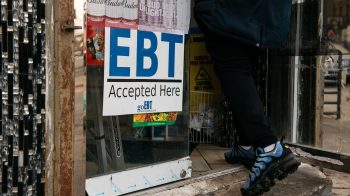States change rules to avoid SNAP cuts
The long-awaited Farm Bill that passed earlier this year promised to cut $8.6 billion out of SNAP – the Supplemental Nutrition Assistance Program formerly known as food stamps – over the next decade. It did so by restricting a practice known as “heat and eat,” which many in Congress saw as a loophole.
Now at least six states are getting around SNAP cuts by tweaking their “heat and eat” programs.
Here’s what more than a dozen “heat and eat” states realized years ago: Give people nominal heating and cooling assistance – even $1 a year – and SNAP recognized them as paying utilities, whether or not they actually did. That’s an expense which triggered more in food stamps.
The new Farm Bill raised that minimum level of help to $20. That was bad news for 70-year-old Barbara Skinner in Philadelphia.
“There was nothing that I could really do about it.” She says. “So I just left it in the hands of God.”
Without “heat and eat” Skinner would eventually lose most of her remaining food stamps. (And remember, SNAP benefits already fell last year when the stimulus ran out).
And while we don’t know if God intervened in this case, Republican Governor Tom Corbett certainly did.
“I was elated,” Skinner says. “If I didn’t have the benefits of SNAP, if I wanted to buy a pair of stockings for church or something, it would be a hardship.”
Corbett and the Democratic governors of New York, Connecticut, Rhode Island, Montana and Oregon have all said to Congress: “We’ll see your 20 dollars” – boosting heating assistance to avoid cuts in SNAP.
Now, by spending about $19 million in mostly federal low-income home energy assistance, these states say they’ll preserve $951 million in SNAP benefits. (Though federal projections may differ, as the story is still unfolding.)
As for criticism that the loophole has returned, “there’s nothing loophole-ish about it,” says Connecticut Governor Dannell Malloy. “They wrote a law. And we acted accordingly to protect the families of Connecticut.”
Antihunger advocates say they’re thrilled states are taking action to preserve “heat and eat” programs at a time when they say SNAP benefits don’t go far enough. Whether or not recipients pay utilities separately from rent, they say the roughly 850,000 low-income households that benefitted from “heat and eat” in the past still have great need.
“Governors are doing what I would do too, if I had the fiduciary responsibility. But it’s sneaky,” says Norm Ornstein, with the American Enterprise Institute.
Make no mistake, Ornstein is a SNAP supporter. He believes the program is underfunded. But he says these workarounds by some states just give fodder to those who want to damage or eliminate the program.
“Congress will be tempted the next time around to set the bar much, much higher,” he says. “And in the process of setting the bar much higher they may hurt needed food stamp recipients, and they may hurt people who need additional heating oil assistance.”
Not long ago House Republicans tried to cut $40 billion out of SNAP. That’s a much different picture than the $8.6 billion in cuts states are unraveling now.
There’s a lot happening in the world. Through it all, Marketplace is here for you.
You rely on Marketplace to break down the world’s events and tell you how it affects you in a fact-based, approachable way. We rely on your financial support to keep making that possible.
Your donation today powers the independent journalism that you rely on. For just $5/month, you can help sustain Marketplace so we can keep reporting on the things that matter to you.


















